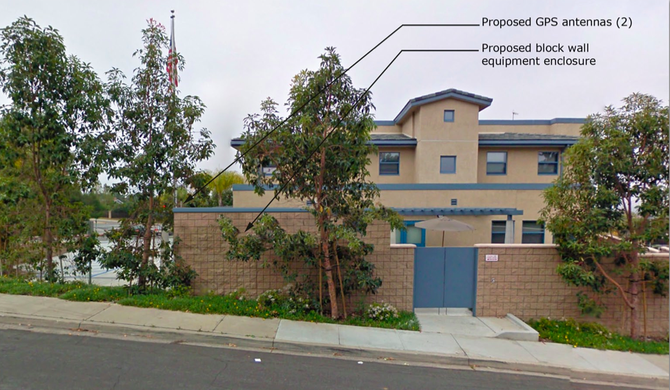 Facebook
Facebook
 X
X
 Instagram
Instagram
 TikTok
TikTok
 Youtube
Youtube

If the City of San Diego approves AT&T's lease proposal, work should begin next spring on a project that includes the installation of 12 antennas on the roof of Fire Station 31 in Del Cerro.
The installation would bring 4G service to the area by the end of summer, AT&T spokesperson Lane Kasselman said in an October 17 interview. He declined to comment on lease details.
According to the city's Real Estate Assets Department, the standardized ten-year telecommunication lease starts with an annual lease payment of $33,600 the first year; rent increases 3 percent annually.
Telecommunication rents go into the city's general fund. The decision to deposit rent money in the general fund was made in 2007 by former mayor Jerry Sanders’s office.
At the September 16 Navajo Community Planners, Inc., meeting, the lease amount was not discussed; but the planning group's unanimous approval of the project includes a request that the city spend lease money in the Navajo community. The planning group makes advisory recommendations for the neighborhoods of Del Cerro, Allied Gardens, San Carlos, and Grantville.
The planners' vote followed a presentation on AT&T's "Lake Murray Fire Station" plan by Shelly Kilbourn of PlanCom, Inc., the firm representing AT&T.
Fire Station 31, which is on the corner of College Avenue and Camino Rico, is located next to St. Therese Catholic Church. The station opened in 1960; it was replaced with a building that opened in December 2005.
Architect Di Donato Associates' plan for the wireless facility adds ten feet to the height of the 20-foot building, along with a 3-foot tall faux chimney. Rooftop antennas are located in the structure, which is "textured and painted to match the existing building." Two GPS antennas will be located in a wall that is currently six feet tall; four feet will be added to accommodate the design.
During the discussion about lease money, a woman in the audience asked, "Is this the best location?" She suggested that an organization such as a church group could benefit from the funds.
Kilbourn replied that the city has a hierarchy for where projects are allowed. These include industrial and commercial areas that are zoned for nonresidential use.
Kasselman acknowledged the city's ranking system and spoke about wireless-facility locations.
"We mask wireless infrastructure behind building façades throughout the nation and California at hundreds of locations,” Kasselman said. “Church steeples, shopping-plaza signs, chimneys, faux trees, and dozens of other techniques are used by our engineers to blend infrastructure into the surroundings.”


If the City of San Diego approves AT&T's lease proposal, work should begin next spring on a project that includes the installation of 12 antennas on the roof of Fire Station 31 in Del Cerro.
The installation would bring 4G service to the area by the end of summer, AT&T spokesperson Lane Kasselman said in an October 17 interview. He declined to comment on lease details.
According to the city's Real Estate Assets Department, the standardized ten-year telecommunication lease starts with an annual lease payment of $33,600 the first year; rent increases 3 percent annually.
Telecommunication rents go into the city's general fund. The decision to deposit rent money in the general fund was made in 2007 by former mayor Jerry Sanders’s office.
At the September 16 Navajo Community Planners, Inc., meeting, the lease amount was not discussed; but the planning group's unanimous approval of the project includes a request that the city spend lease money in the Navajo community. The planning group makes advisory recommendations for the neighborhoods of Del Cerro, Allied Gardens, San Carlos, and Grantville.
The planners' vote followed a presentation on AT&T's "Lake Murray Fire Station" plan by Shelly Kilbourn of PlanCom, Inc., the firm representing AT&T.
Fire Station 31, which is on the corner of College Avenue and Camino Rico, is located next to St. Therese Catholic Church. The station opened in 1960; it was replaced with a building that opened in December 2005.
Architect Di Donato Associates' plan for the wireless facility adds ten feet to the height of the 20-foot building, along with a 3-foot tall faux chimney. Rooftop antennas are located in the structure, which is "textured and painted to match the existing building." Two GPS antennas will be located in a wall that is currently six feet tall; four feet will be added to accommodate the design.
During the discussion about lease money, a woman in the audience asked, "Is this the best location?" She suggested that an organization such as a church group could benefit from the funds.
Kilbourn replied that the city has a hierarchy for where projects are allowed. These include industrial and commercial areas that are zoned for nonresidential use.
Kasselman acknowledged the city's ranking system and spoke about wireless-facility locations.
"We mask wireless infrastructure behind building façades throughout the nation and California at hundreds of locations,” Kasselman said. “Church steeples, shopping-plaza signs, chimneys, faux trees, and dozens of other techniques are used by our engineers to blend infrastructure into the surroundings.”
Comments